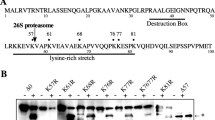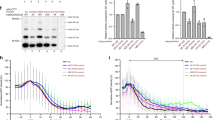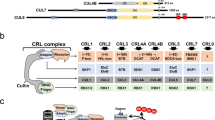Abstract
CELL cycle progression in eukaryotes is controlled by the p34cdc21CDC28 protein kinase and its Short-lived, phase-specific regulatory subunits called cyclins1,2. In Xenopus oocytes, degradation of M-phase (B-type) cyclins is required for exit from mitosis and is mediated by the ubiquitin-dependent proteolytic system3. Here we show that B-type-cyclin degradation in yeast involves an essential nuclear ubiquitin-conjugating enzyme, UBC9. Repression of UBC9 synthesis prevents cell cycle progression at the G2 or early M phase, causing the accumulation of large budded cells with a single nucleus, a short spindle and replicated DNA. In ubc9 mutants both CLB5, an S-phase cyclin4,5, and CLB2, an M-phase cyclin6,7, are stabilized. In wild-type cells the CLB5 protein is unstable throughout the cell cycle, whereas CLB2 turnover occurs only at a specific cell-cycle stage8. Thus distinct degradation signals or regulated interaction with the ubiquitin-protein ligase system may determine the cell-cycle specificity of cyclin proteolysi
This is a preview of subscription content, access via your institution
Access options
Subscribe to this journal
Receive 51 print issues and online access
$199.00 per year
only $3.90 per issue
Buy this article
- Purchase on Springer Link
- Instant access to full article PDF
Prices may be subject to local taxes which are calculated during checkout
Similar content being viewed by others
References
Murray, A. & Kirschner, M. W. Science 246, 614–621 (1989).
Nasmyth, K. Curr. Opin. Cell Biol. 5, 166–179 (1993).
Glotzer, M., Murray, A. W. & Kirschner, M. W. Nature 349, 132–138 (1991).
Epstein, C. & Cross, F. Genes Dev. 6, 1695–1706 (1992).
Schwob, E. & Nasmyth, K. Genes Dev. 7, 1160–1175 (1993).
Surana, U. et al. Cell 65, 145–161 (1991).
Ghiara, J. B. et al. Cell 65, 163–174 (1991).
Amon, A., Irniger, S. & Nasmyth, K. Cell 77, 1037–1050 (1994).
Jentsch, S. A. Rev. Genet. 26, 177–205 (1992).
Finley, D. & Chau, V. A. Rev. Cell Biol. 7, 25–69 (1991).
Hershko, A. & Ciechanover, A. A. Rev. Biochem. 61, 761–807 (1992).
Jentsch, S., McGrath, J. P. & Varshavsky, A. Nature 329, 131–134 (1987).
Goebl, M. G., Yochem, J., Jentsch, S., McGrath, J. P., Varshavsky, A. & Byers, B. Science, 241, 1331–1335 (1988).
Seufert, W. & Jentsch, S. EMBO J. 9, 543–550 (1990).
Seufert, W., McGrath, J. P. & Jentsch, S. EMBO J. 9, 4535–4541 (1990).
Wiebel, F. & Kunau, W.-H. Nature 359, 73–76 (1992).
Sommer, T. & Jentsch, S. Nature 365, 176–179 (1993).
Jungmann, J., Reins, H.-A., Schobert, C. & Jentsch, S. Nature 361, 369–371 (1993).
Ellison, K. S., Gwozrd, T., Prendergast, J. A., Paterson, M. C. & Ellison, M. J. J. biol. Chem. 266, 24116–24120 (1991).
Weinert, T. A. & Hartwell, L. H. Science 241, 317–322 (1988).
Hartwell, L. H. J. molec. Biol. 104, 803–817 (1976).
Heinemeyer, W., Kleinschmidt, J. A., Saidowsky, J., Escher, C. & Wolf, D. H. EMBO J. 10, 555–562 (1991).
Seufert, W. & Jentsch, S. EMBO J. 11, 3077–3080 (1992).
Surana, U. et al. EMBO J. 12, 1969–1978 (1993).
Holloway, S. L., Glotzer, M., King, R. W. & Murray, A. W. Cell 73, 1393–1402 (1993).
Ghislain, M., Udvardy, A. & Mann, C. Nature 366, 358–362 (1993).
Hershko, A. et al. J. biol. Chem. 269, 4940–4946 (1994).
Chen, P., Johnson, P., Sommer, T., Jentsch, S. & Hochstrasser, M. Cell 74, 357–369 (1993).
Ausubel, F. M. et al. (eds) Current Protocols in Molecular Biology (Green and Wiley, New York, 1994).
Tyers, M., Tokiwa, G., Nash, R. & Futcher, B. EMBO J. 11, 1773–1784 (1992).
Author information
Authors and Affiliations
Rights and permissions
About this article
Cite this article
Seufert, W., Futcher, B. & Jentsch, S. Role of a ubiquitin-conjugating enzyme in degradation of S- and M-phase cyclins. Nature 373, 78–81 (1995). https://doi.org/10.1038/373078a0
Received:
Accepted:
Issue Date:
DOI: https://doi.org/10.1038/373078a0
This article is cited by
-
The SUMO–NIP45 pathway processes toxic DNA catenanes to prevent mitotic failure
Nature Structural & Molecular Biology (2023)
-
Signalling mechanisms and cellular functions of SUMO
Nature Reviews Molecular Cell Biology (2022)
-
SUMO conjugating enzyme: a vital player of SUMO pathway in plants
Physiology and Molecular Biology of Plants (2021)
-
SUMO proteins in the cardiovascular system: friend or foe?
Journal of Biomedical Science (2020)
-
An unanticipated tumor-suppressive role of the SUMO pathway in the intestine unveiled by Ubc9 haploinsufficiency
Oncogene (2020)
Comments
By submitting a comment you agree to abide by our Terms and Community Guidelines. If you find something abusive or that does not comply with our terms or guidelines please flag it as inappropriate.



